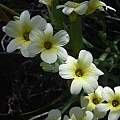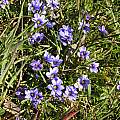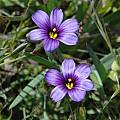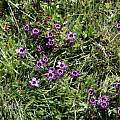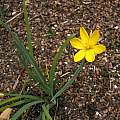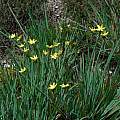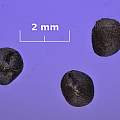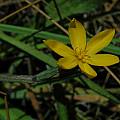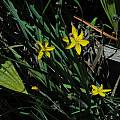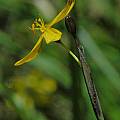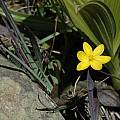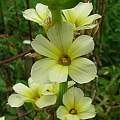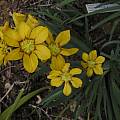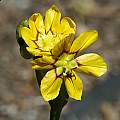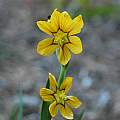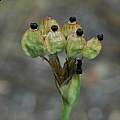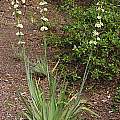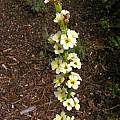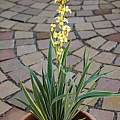Sisyrinchium L. is the largest genus in the Iridaceae family in the Americas. There are 37 species recognized in North America and 92 species in temperate South America, an undetermined number in central America, one from Greenland, and one in Ireland that people also include in this genus. Other species are naturalized elsewhere. A total estimate is around 140. This genus includes small to medium sized seasonal perennials or rarely annuals with rhizomes or indistinct rootstocks. Roots can be thick and fleshy or tuberous. Plants have grasslike leaves and purple to blue, yellow, or occasionally white flowers. Sisyrinchium is the central genus of Sisyrinchieae, a tribe that includes Libertia, Olsynium, Orthrosanthus Solenomelus and Tapeinia?. Olsynium was previously included in Sisyrinchium. More information on this genus can be found in The Iris Family by Peter Goldblatt and John C. Manning.
Sisyrinchium arenarium Poepp. is a yellow flowered species distributed from central Chile to Argentina. Height range: 20-50 cm. Photo by Osmani Baullosa.
Sisyrinchium bellum S.Watson, known as Blue-eyed Grass, is found in open grassy places in the Pacific states blooming for a long time in spring to summer. Height range: 30-45 cm. The first two photographs by Bob Rutemoeller from wild plants blooming in Sonoma County, California. The last was taken by Mary Sue Ittner at Navarro Point in Mendocino County.
Sisyrinchium californicum (Ker Gawl.) W.T.Aiton, known as yellow-eyed or golden-eyed grass, is found near the coast in wet places from British Columbia to central California. It has bright yellow flowers. It is almost too good a garden plant if grown in a sunny spot with adequate moisture since it reseeds well, but dies out over time in a summer dry garden. Height range: 15-40 cm. Photos 1 and 2 by Mary Sue Ittner. Photo 3 of seed by David Pilling.
Photos from Salt Point State Park, Sonoma County, California where it is found growing only in marshy places or areas that get extra water such as road verges. Photos by Mary Sue Ittner and Bob Rutemoeller.
Sisyrinchium convolutum Nocca has a large range from Mexico to Peru. Height range: 15-40 cm. Photo by Kathleen Sayce.
Sisyrinchium macrocarpum Hieron. is a species from Argentina. Height range: 20-50 cm. The first photo was taken May 2004 by Bob Rutemoeller in Harry Hay's gardens. It had been grown from seed sown in 2003. The next three photos were taken by Mary Sue Ittner of flowers and the unusual seed pods. She grew it from seed and flowered it in her Mediterranean climate, but it lasted only two years with a dry summer.
Sisyrinchium striatum Sm. is native to Chile and Argentina. It has gray green leaves and spike-like clusters of pale yellow flowers to about 3 ft. It needs some summer water and care to cut off spent flowers to prevent new seedlings from appearing in great quantities. A bed at the UC Botanical Garden is almost completely taken over by this aggressive species. Growers in Mediterranean-type climates beware. Photos by Mary Sue Ittner and Martin Bohnet.
